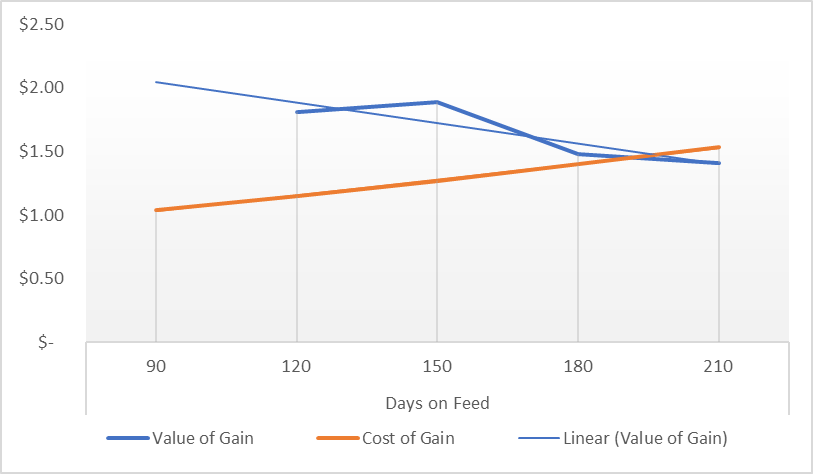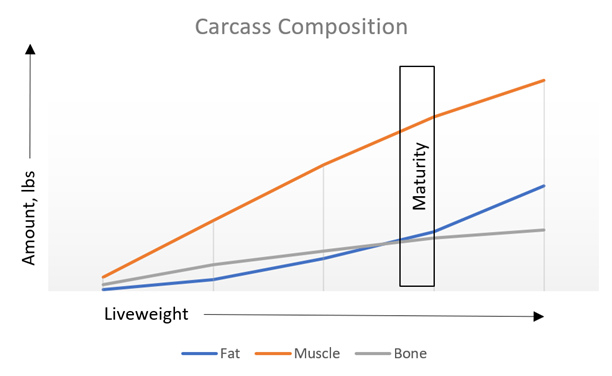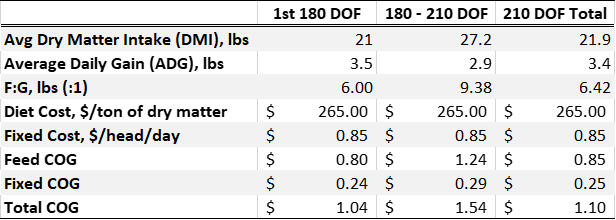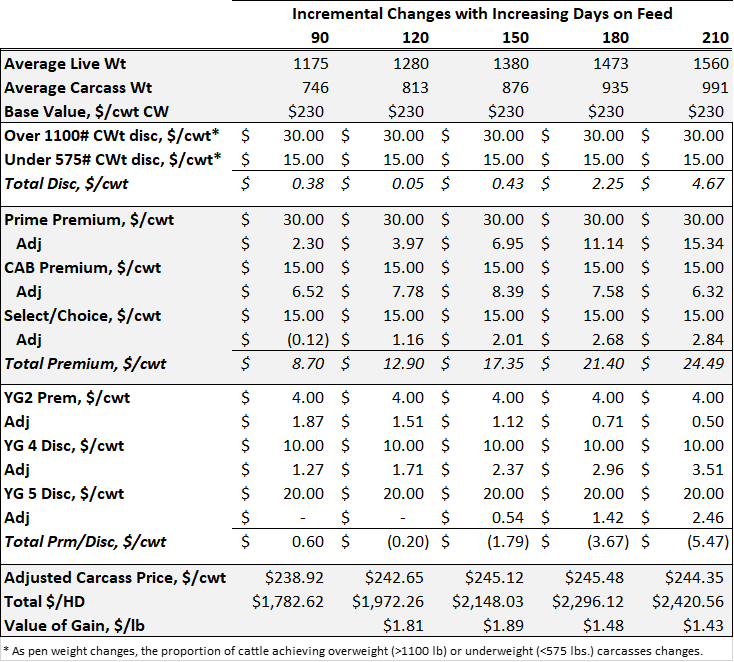In marketing fed cattle, the old saying rings true: “The more things change, the more they stay the same.” Today’s cattle may be priced in intricate ways such as value-based grids, but traditional factors such as markets, input costs and weight still drive marketing decisions. Understanding the variables involved in deciding whether to add more days on feed (DOF) is critical to cattle feeder’s making a decision that optimizes returns on investment.
Cost vs. value of gain
We know that more days on feed yields cattle and carcasses with more total sellable pounds, but ultimately the decision about how long to maintain cattle on feed comes down to this: Does the opportunity for increased value outpace the risk for increased cost?
The input side of this equation is dependent on ingredient costs and feed efficiency. The value side relies on several factors, but for grid-marketed animals, the most important factor is the ability to market a greater number of heavier-weight cattle achieving premium-quality grades. Profitable cattle are marketed prior to or at the point where costs exceed value potential, as shown below.

Feed efficiency, gain and carcass traits that change over time also vary, sometimes highly, between different groups of cattle. While having a history for every group might be helpful, most cattle will not have a known source. Understanding how performance and carcass traits change over time is generally your best opportunity to evaluate the incremental value and cost of gain (COG), which will drive your decision-making on DOF.
Composition of gain
The term “composition of gain” refers to the proportions of gain attributed to muscle, fat, and bone as shown in Figure 2 below. As these proportions shift away from muscle to fat so does feed efficiency and total gain.
Like us, young animals have a greater proportion of their gains going to muscle, while older animals shift to gaining a greater proportion of fat. Growth in the form of muscle is more efficient and requires less total net energy for gain than growth in the form of fat. This helps explain why after maturity, average daily gain (ADG) declines.

Feed Conversion
Feed conversion is often measured by feed to gain (F:G), the number of dry matter pounds needed for an animal or group of animals to achieve one pound of gain. A higher number indicates a less efficient animal or group of animals (e.g., 10:1 vs. 6:1).
Because composition of gain changes as an animal achieves maturity, feed efficiency becomes poorer. When deciding whether to maintain cattle for a greater number of DOF, consider the impact that reduced efficiency has on COG. Table 1 shows what COG may look like if cattle are fed for an additional 30 days.
Table 1. Poor performance at the end of the feeding period negatively affects cost of gain.

The takeaway is that we can expect poorer performance at the end of the feeding period. Delaying the marketing of heavyweight cattle is expensive, so the cost must be outweighed by value gained, either through rising markets or improvements in carcass characteristics.
Carcass Traits
We can’t control the markets, but we can manage carcass outcomes with DOF. When cattle are being sold on a grid, a few traits are particularly important in determining carcass value. These include quality grade, physiological age, yield grade and carcass weight. One of the primary challenges is that as DOF increase, some traits boost total carcass value (marbling and carcass weight) while others decrease it (physiological age, carcass weight and yield grade).
Understanding how grids and their premiums and discounts work will inform the decision of when to market fed cattle. In particular, the desire for premium-quality carcasses — those that grade average choice or higher — can be an incentive for a longer feeding duration. However, chasing these premiums can also result in potential discounts due to a greater number of yield grade 4s and 5s and overweight carcasses.
Table 2 describes the changes in a hypothetical group of grid-marketed cattle at various DOF. Considering the effect of composition changes (Figure 1), we see how these outcomes correlate with value of gain declining over time. The data in Table 2 also demonstrates why feeding for greater DOF can be attractive to cattle feeders. The greater number of DOF generates more total dollars per head, and increases in quality grade add to carcass value on a per hundredweight basis, up to a point.
Table 2. Hypothetical premiums and discounts of grid-marketed cattle at increasing days on feed demonstrate where changes in carcass value come from as cattle attain heavier weights.

Conclusion
It’s not easy to decide when to market cattle; it’s tempting to hang on to them a little longer in the hope of gaining more sellable pounds. While having history on the animals can improve your ability to assess when cost of gain exceeds value gained, a basic understanding of the changes that occur with maturity is needed to make the best call.
- Log in to post comments
